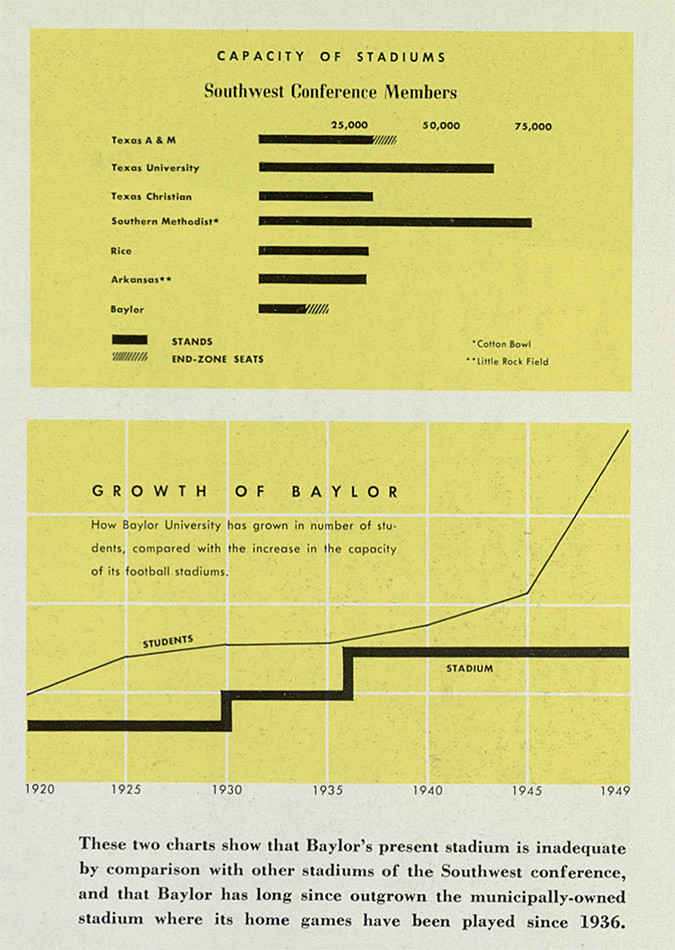by Amanda Norman, University Archivist

It’s back to school today—time for a quiz! These Baylor trivia questions are drawn from things I’ve learned through assisting patrons with reference questions. Test your knowledge of the green and gold—or learn more about Baylor’s past!
- When did Baylor have its first female yell leader?
- In the 1950s-1960s, AFROTC cadets practiced their rifle shooting in an indoor range in what building? a) Bill Daniel Student Center b) Rena Marrs McLean Gymnasium c) Penland Hall
- What does legend say is buried near the swing in Burleson Quadrangle?
- How many years elapsed between when Tidwell Bible Building was first proposed and when it was completed?
- True or False—A Baylor student designed the Baylor seal in the floor of the Pat Neff Hall foyer.
- How much money did George W. Truett raise to eliminate Baylor’s debt in his role as financial agent in the early 1890s?
- Sociology is a part of the College of Arts and Sciences now, but it hasn’t always been housed there. In what school did it reside in the 1920s?
- What subject did the first African-American professor at Baylor teach?
- How many classes celebrated their graduation at Baylor Stadium (now Floyd Casey Stadium)?
- Who coined Baylor’s motto, Pro Ecclesia, Pro Texana?


Answers
- Weta Timmons was elected a yell leader in 1923 and is heartily commended for her efforts in the Lariat. However, after her term and up to 1968, there were no female yell leaders. The decision to break that gender gap was much debated throughout the 1960s.
- a) Bill Daniel Student Center. From 1953 to about 1964, the AFROTC competitive shooting team carried rifles up four flights of stairs to the attic of the Student Union Building and practiced target shooting. Apparently you could hear the shots outside the building (through air vents) but not inside.
- An “Indian princess” from the Huaco Indian tribe. When Colonel Joseph Warren Speight owned the property, his daughters found turquoise beads beneath a tree where they were playing. Speight investigated and found the skeleton. According to a Huaco legend, a plague befell the tribe. The chief’s beloved daughter helped nurse the ill but eventually died herself, and the bones are hers. In the 1930s, a marker declaring the grave to be that of “an Indian Princess” was erected on the site but was later removed and then returned in 1988.
- Twenty-one years. The building was first conceived in 1933 but wasn’t completed till 1954. It was delayed due to fundraising challenges, including World War II and other building priorities like Baylor Stadium, Armstrong Browning Library, and the Student Union Building. Architectural problems also delayed the project—an overly ambitious initial design, leading to a new architect being engaged and a lawsuit. Check out BU Records: Tidwell Bible Building Campaign Committee at The Texas Collection
- True. Enrique Ramirez designed the seal for the building, which was completed in 1939. Ramirez was an art student who did various art and design projects for the university throughout his time at Baylor.
- Truett raised $100,000 in two years. Benajah Harvey (B.H.) Carroll, the president of the board of trustees, offered the job of financial agent to Truett, who accepted the position but suffered a bad case of the measles before he could start the job. After completing the fundraising project, Truett enrolled at Baylor as a student in 1893, and, of course, went on to become a major figure in Texas Baptist history. In 1990, Baylor claimed his name for a future seminary, and in 1994, the first students began classes at George W. Truett Theological Seminary at Baylor University. Check out the George W. Truett papers at The Texas Collection. We also have many of the books he authored and audio recordings of his sermons.
- The School of Commerce and Business Administration, which was founded in 1923 (and now is known as the Hankamer School of Business). Political science and journalism are a few other departments that were housed in the new program but eventually were moved to the College of Arts and Sciences.
- Vivienne Malone-Mayes was hired as a mathematics professor at Baylor in 1966—only five years after she had been denied admittance to the school as a graduate student. She was among the first black women in the nation to earn a PhD in mathematics. Check out the Vivenne Malone-Mayes papers at The Texas Collection and her oral memoirs from the Institute for Oral History.
- Five. The classes of 1951-1955 celebrated commencement exercises at Baylor Stadium. In 1956, President Eisenhower came to Baylor and gave the commencement address. According to the Lariat, his advisors “much preferred that he speak in a completely enclosed building,” so the venue was moved that year to the (un-air conditioned and thus very warm) Heart O’ Texas Coliseum. Commencement was held there until 1988, when the Ferrell Center was constructed.
- Rufus Burleson. When he accepted the presidency of the university in 1851, he included an outline of institutional policies. Number eight on the list was, “The mottoes of Baylor University shall be, “Pro Ecclesia, Pro Texana;” “Dulce et Decorum, pro patria Mori.” The Baylor seal still boasts the first motto, which translates to “For Church, For Texas.” The latter quote is attributed to the Roman poet Horace, and roughly translates to, “It is sweet and proper to die for your country.” It fell out of use as an official slogan—really, it’s not clear if it ever was adapted. Check out the Rufus C. Burleson papers at The Texas Collection.
You can read more about these stories and many others in the digitized Lariats, Round-Ups, and press releases, just a few of many Texas Collection items that can be found on the Baylor Digital Collections site. And if you want to investigate even further, drop me a line at The Texas Collection—we have archival records on many of these people and places.





